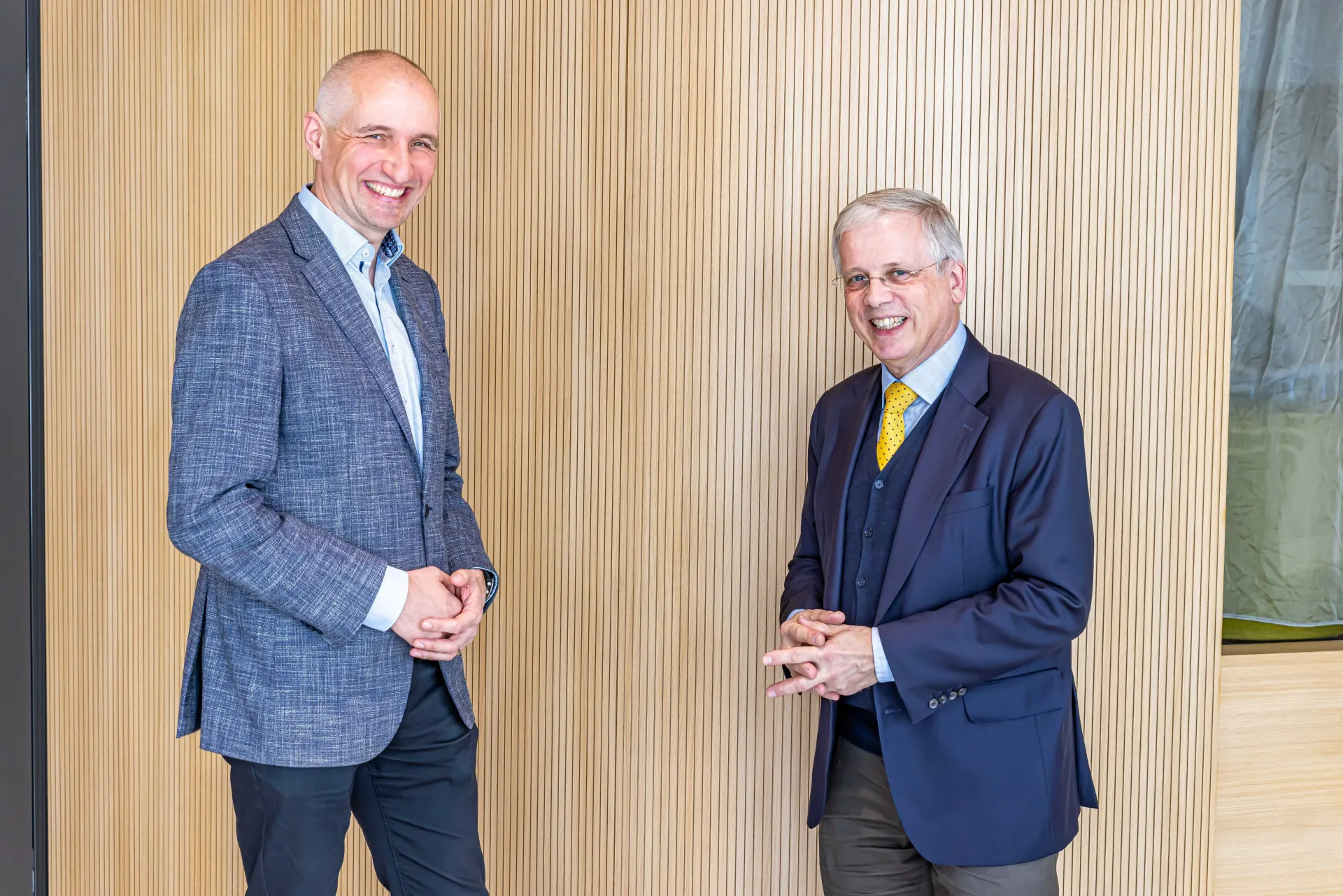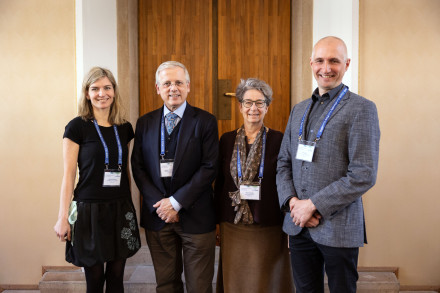What is the main aim of the EuroFlow Consortium from a medical perspective?
We strive for the best diagnostics to support therapy for patients with leukaemia or immunodeficiencies, whether they’re in Prague, Paris, Salamanca or any other place in Europe and beyond. We aim to have the same standardised high-quality diagnostics for all patients. Continuous innovation and standardisation improves our diagnostics for guiding therapy, including monitoring whether the treatment is effective. That is the basis of our Holy Grail.
Projects come and go. How do you make them last?
This is a crucial part of management. You need to clearly define the aims, work-packages, pathways and timelines. Every centre has to contribute to several work-packages; we divide responsibilities among different teams, so each work-package involves at least three up to ten centres. This makes the process efficient and teams bring complementary value; if one team cannot deliver, the other teams can supplement.
How do you secure ongoing funding?
That is the biggest challenge. It’s why we protect all new steps and inventions, and write and file patents. These patents are licensed to companies: they market the new diagnostic tests and pay royalties to the group – not to the individual institutes or individual inventors. Typically, that brings about a five percent return. This is enough income to continue our collaboration, organise meetings as well as to support some personnel.
Is it acceptable for the cooperating universities that royalties go to the consortium and not to them?
We learnt from previous collaborations that everything needs to be arranged in advance through a consortium agreement at the outset. Subsequently, all research and work-packages have to be organised collectively, so that the new ideas and new steps can be achieved collectively.
Initially some universities had difficulty with the consortium system, insisting revenue should go to individual institutes. We refused, stating that this was not part of the consortium agreement, but that the intellectual property is collectively owned.
How widespread is this model?
As I have understood from the European Commission, we are the only group in Europe using this model; there is no equivalent. We have installed an umbrella organisation, the European Scientific foundation of Laboratory Hemato-Oncology (ESLHO), which includes EuroClonality, EuroMRD and EuroFlow, all collaborating in a comparable way.
Is the data safe under this collective system?
I dare to say nobody in the team is afraid that somebody will run off with their data, there is a lot of trust. Moreover, it is always clear who has the first authorship and who is responsible.
Has anybody let you down badly enough that you had to cancel the cooperation with them?
It is very rare, but people are young, they make mistakes... If it happens, I act. Not publicly, of course. That is my task as chairman.
How many institutes are currently involved in EuroFlow and other consortia?
EuroFlow has had 30 different institutes over time; nineteen are still active. In the others like EuroClonality, it’s around 25, at times it was more than 30. EuroMRD is still growing; it’s at about 70 now. In total, the three ESLHO consortia involve over 100 different medical or university institutes, which includes around ten percent of members outside Europe.
How many consortia have you founded in total?
In my entire career, I have participated in 15 and chaired seven. I try to be as open as possible about how to manage and encourage young people to get involved. Technically I am already retired, but in practice, I continue so that the younger generation can stepwise take over.
What exactly is your field or discipline? You are a medical doctor, but you work in immunology, genetics, oncology...
I am a medical immunologist. I specialised in anything that can go wrong in or around the human immune system: infectious diseases, vaccinations, immunodeficiencies, autoimmune diseases, allergies, and tumours of immune cells, like leukaemias and lymphomas.
Every medical field interacts with the immune system and none can work without understanding it.
Where does immunology fit within medicine?
Immunology plays a central and dominant role in all aspects of medicine! The body is all about the immune system: it can cause a problem if it fails to do its job, or solve it; sometimes there is a genetic disorder acquired or inherited. This kind of understanding is fundamental to the field of immunology.
Every medical field interacts with the immune system and none can work without understanding it. Tissue renewal after surgery is driven by the immune system, influenced by genetics. In intensive care, the body’s ability to manage tissue damage relies on immune system cells like macrophages and granulocytes. Even atherosclerosis, inflammation leading to debris in vessel walls, is a cardiac disease marked by calcium precipitation in arteries, which is a typical immune response to chronic inflammation. So, all fields of medicine need knowledge about the immune system.
So it is a kind of super-discipline.
I am glad it is being understood more and more. EuroFlow is at the forefront of this field because the best way to understand the immune system is by analysing the immune cells. Under the microscope, you might see ten different immune cells – by flow cytometer, you see thousands of different immune cells.
Tell us about your recent project, the technological core facility for flow cytometry in Leiden. How big is it and what is it used for?
This project stemmed from the mindset I developed through learning collaboration. A university council entrusts expensive, million-euro equipment to departments, groups, or, in exceptional cases, individuals. In my opinion – I am not a communist, but for practical reasons – such expensive equipment should be accessible to everyone within the scientific community.
With this mindset, I arrived in Leiden to start an immune monitoring programme, where all the equipment and technologies, including 25 cytometers, were scattered all over around 22 departments around the university and the University Hospital, each with its own setup. As the head of my team, I took on the task of organising and bringing them together.
Such expensive equipment should be accessible to everyone within the scientific community.
How did you manage to reorganise the whole thing?
It is an enormous time investment because you have to talk with all those people, department after department, office by office. I explained the benefits of centralised management, central maintenance, daily setup of instruments, daily checks, and availability for everyone without exception. Then we assembled a team of experienced technicians to provide training for everyone.
We began daily monitoring and documenting each instrument to quickly identify any issues. Routine monitoring of instrument set-up and maintenance allowed us to anticipate and address problems before damage occurs, ensuring instruments operate more consistently and rarely break down.
I implemented a special software system to document facility operations, allowing us to track usage, duration of usage and running costs per instrument, allowing for calculation of fair hourly costs. Scientists, PhD students and technicians log in under their own code, making it transparent what costs are being charged to which budget. Transparency is critical, because this increases trust.
Which tasks need the most sensitivity and experience?
You have to take care of everyone who asks to use the facility. It is very important to strike a subtle balance between support and supervision – you have to be strict because the facility should not be misused.
When a colleague misused the facility three times, I blocked his access until he explained himself. Word got around, preventing further incidents. However, it is important not to be too strict, as it can negatively affect the experiments. So, under all circumstances we try to have a fair balance, always in favor of having the facility in optimal condition and accessible for all users.
How did you find people with the right mindset?
We conducted numerous interviews. Of course, sometimes we make mistakes; you cannot identify everything in a few interviews. Operators need to be team builders with an open mind and with a support and teaching attitude. Operators that prefer to work alone may not be ideal for a large facility, where continuous interaction with many different users is critical. Over a period of nine months, we built the first team of seven operators.
That’s incredibly precise management...
It was demanding, but we had to do it rightly. Particularly during the first year, we wished to avoid complaints, because so many different departments trusted us in using their cytometers for building the central facility! Fortunately, it worked our nicely! No department re-claimed its instruments!
4. 3. 2025
Ve dnech 19. až 21. února se v Karolinu konal první zimní kurz EuroFlow zaměřený na minimální reziduální nemoc (MRD)...


